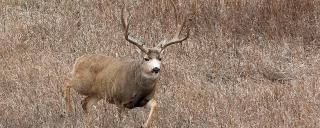
Mule Deer Habitat
General Information
Mule deer, named for their mule-like ears, occur in western North America. Historically, mule deer numbers in the 1800s were similar to today. Mule deer were relatively scarce during the early 1900s following settlement, a time of unrestricted subsistence and market hunting, excessive livestock grazing and unfavorable weather patterns. Mule deer populations rebounded and flourished across the west during the 1950s and early 1960s after improvements in habitat management, regulation of hunting and stricter law enforcement. After a population peak, mule deer populations have experienced a declining trend due to changes in habitat conditions. Prior to European settlement, mule deer occupied all of North Dakota, with highest numbers found in the western badlands. As it was prior to settlement, the western badlands still have the highest densities of mule deer in the state. North Dakota is on the eastern fringe of their overall distribution and is a minor contributor to mule deer in North America.
General Habitat Requirements
Mule deer diets vary by the availability of forage in a particular region. Mule deer are considered opportunistic concentrate selectors that forage across the landscape in search of high quality foods, typically shrubs and trees, followed by forbs, then grasses. Mule deer also take advantage of high quality agricultural crops and feeds grown in North Dakota. The primary range of mule deer in North Dakota occurs in the badlands, which consists of a rugged landscape of clay buttes, covered by Rocky Mountain Juniper and green ash stands interspersed with a mixture of sagebrush, deciduous shrubs and grasses. Agricultural crops are grown along river bottoms and flats adjacent to the badlands and are utilized by mule deer. Secondary ranges occur east of the badlands to the Missouri River, and consist of a landscape dominated by agricultural activities, interspersed with wooded draws, CRP, and native grasslands encompassing rugged buttes. Water is not a limiting factor for mule deer in North Dakota.
Management Considerations
- Incorporate grazing plans that prevent overgrazing and encourage a diverse landscape of grasses, shrubs and forbs.
- Preserve native prairie. It is not recommended to convert native prairie for wildlife food plots, introduced grass species, trees, etc.
- Use prescribed grazing plans to eliminate overutilization of woody draws, mesic swales and riparian areas.
- If three-strand wire fences are being constructed, the bottom wire should be smooth and placed 16-18 inches above the ground to allow fawns to move under the bottom wire, with a maximum fence height of 42 inches.
- Do not start an artificial feeding program, such as feeders, bait stations, corn piles, etc. Five to 10 deer at a feeder can quickly turn into 50 to 100 deer and a much larger management problem.
